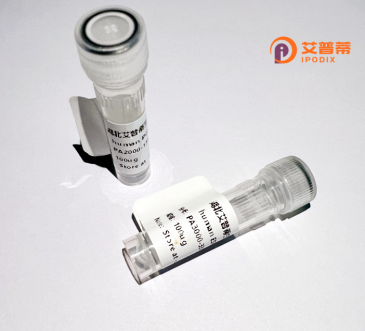
| 纯度 | >90%SDS-PAGE. |
| 种属 | Human |
| 靶点 | ASB1 |
| Uniprot No | Q9Y576 |
| 内毒素 | < 0.01EU/μg |
| 表达宿主 | E.coli |
| 表达区间 | 1-335aa |
| 氨基酸序列 | MAEGGSPDGR AGPGSAGRNL KEWLREQFCD HPLEHCEDTR LHDAAYVGDL QTLRSLLQEE SYRSRINEKS VWCCGWLPCT PLRIAATAGH GSCVDFLIRK GAEVDLVDVK GQTALYVAVV NGHLESTQIL LEAGADPNGS RHHRSTPVYH ASRVGRADIL KALIRYGADV DVNHHLTPDV QPRFSRRLTS LVVCPLYISA AYHNLQCFRL LLLAGANPDF NCNGPVNTQG FYRGSPGCVM DAVLRHGCEA AFVSLLVEFG ANLNLVKWES LGPESRGRRK VDPEALQVFK EARSVPRTLL CLCRVAVRRA LGKHRLHLIP SLPLPDPIKK FLLHE |
| 分子量 | 62.59 kDa |
| 蛋白标签 | GST-tag at N-terminal |
| 缓冲液 | 冻干粉 |
| 稳定性 & 储存条件 | Lyophilized protein should be stored at ≤ -20°C, stable for one year after receipt. Reconstituted protein solution can be stored at 2-8°C for 2-7 days. Aliquots of reconstituted samples are stable at ≤ -20°C for 3 months. |
| 复溶 | Always centrifuge tubes before opening.Do not mix by vortex or pipetting. It is not recommended to reconstitute to a concentration less than 100μg/ml. Dissolve the lyophilized protein in distilled water. Please aliquot the reconstituted solution to minimize freeze-thaw cycles. |
1. **文献名称**: *Structure and Function of the Ankyrin Repeat and SOCS Box (ASB) Protein Family*
**作者**: Kile, B.T., et al.
**摘要**: 该研究解析了ASB1的蛋白结构,指出其通过锚蛋白重复序列介导底物识别,并利用SOCS框连接E3泛素连接酶复合体,参与调控泛素-蛋白酶体降解通路,为理解ASB家族蛋白的分子机制奠定了基础。
2. **文献名称**: *SOCS Box Proteins in Cellular Ubiquitination Pathways*
**作者**: Krebs, D.L., et al.
**摘要**: 文章系统研究了含SOCS框蛋白的功能,提出ASB1通过调控特定底物的泛素化降解影响细胞信号转导,尤其是JAK-STAT通路,揭示了其在免疫应答和细胞分化中的潜在作用。
3. **文献名称**: *ASB1 Negatively Regulates Cell Proliferation in Colorectal Cancer*
**作者**: Huang, Y., et al.
**摘要**: 该研究发现ASB1在结直肠癌细胞中低表达,其过表达可抑制肿瘤生长并诱导细胞周期停滞,机制可能与泛素化降解促癌蛋白(如Cyclin D1)有关,提示ASB1的抑癌功能。
4. **文献名称**: *CRISPR Screening Identifies ASB1 as a Regulator of Mitochondrial Metabolism*
**作者**: Smith, A.D., et al.
**摘要**: 通过全基因组CRISPR筛选,发现ASB1缺失导致线粒体呼吸链复合物蛋白稳定性异常,影响细胞能量代谢,为ASB1在代谢性疾病中的研究提供了新方向。
每篇文献覆盖了ASB1的结构、泛素化调控、疾病关联及新兴功能研究,反映其多维生物学意义。
**Background of Ankyrin Repeat and SOCS Box Protein 1 (ASB1)**
ASB1 is a member of the ankyrin repeat and SOCS box (ASB) protein family, comprising 18 members in humans. It is characterized by tandem ankyrin repeat motifs at the N-terminus and a C-terminal SOCS (Suppressors of Cytokine Signaling) box domain. The ankyrin repeats mediate protein-protein interactions, enabling ASB1 to recruit substrates, while the SOCS box facilitates binding to elongin B/C, cullin 5. and Rbx1. forming an E3 ubiquitin ligase complex (ECS type). This complex targets specific proteins for ubiquitination and subsequent proteasomal degradation.
ASB1 is widely expressed in tissues, including the brain, heart, and immune cells, and is implicated in diverse cellular processes such as signal transduction, proliferation, and apoptosis. Studies suggest roles in regulating cytokine signaling, particularly pathways involving JAK-STAT, though its exact physiological substrates remain unclear. Emerging evidence links ASB1 dysregulation to diseases; for example, elevated ASB1 levels are observed in certain cancers (e.g., breast, colon), potentially promoting tumor growth by degrading tumor suppressors. Conversely, its role in immune modulation hints at involvement in inflammatory disorders.
Despite progress, ASB1's mechanistic details and context-dependent functions require further exploration, particularly in vivo. Its dual structural domains and E3 ligase activity position ASB1 as a potential therapeutic target, though current research remains preclinical.
×